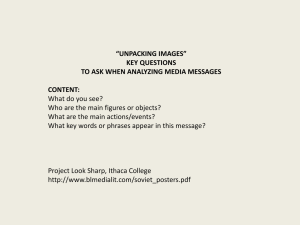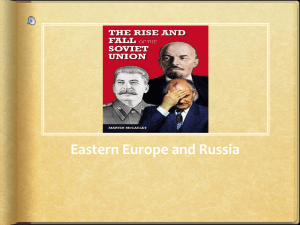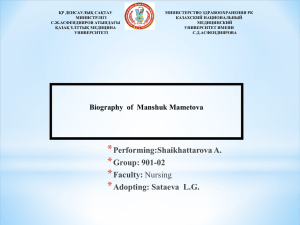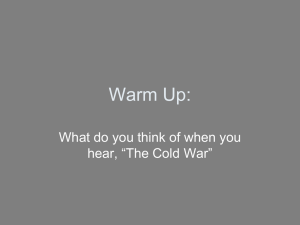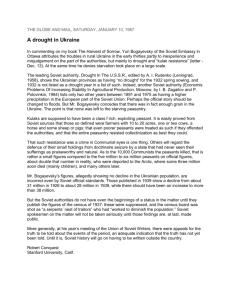Where Historians Disagree
advertisement
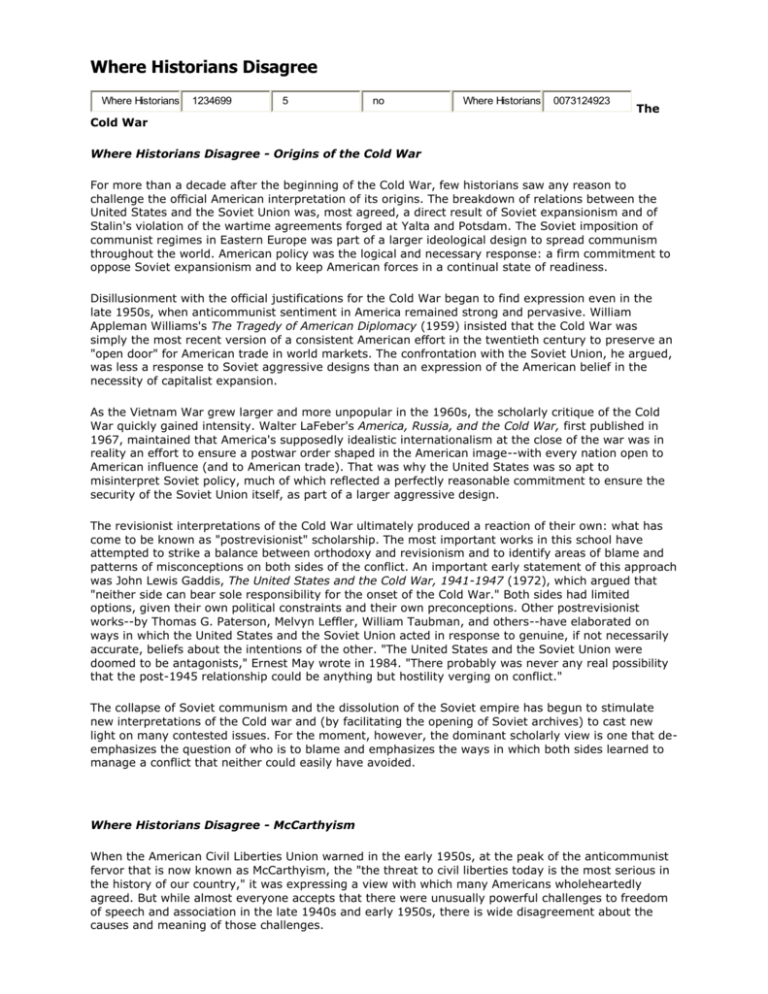
Where Historians Disagree Where Historians 1234699 5 no Where Historians 0073124923 The Cold War Where Historians Disagree - Origins of the Cold War For more than a decade after the beginning of the Cold War, few historians saw any reason to challenge the official American interpretation of its origins. The breakdown of relations between the United States and the Soviet Union was, most agreed, a direct result of Soviet expansionism and of Stalin's violation of the wartime agreements forged at Yalta and Potsdam. The Soviet imposition of communist regimes in Eastern Europe was part of a larger ideological design to spread communism throughout the world. American policy was the logical and necessary response: a firm commitment to oppose Soviet expansionism and to keep American forces in a continual state of readiness. Disillusionment with the official justifications for the Cold War began to find expression even in the late 1950s, when anticommunist sentiment in America remained strong and pervasive. William Appleman Williams's The Tragedy of American Diplomacy (1959) insisted that the Cold War was simply the most recent version of a consistent American effort in the twentieth century to preserve an "open door" for American trade in world markets. The confrontation with the Soviet Union, he argued, was less a response to Soviet aggressive designs than an expression of the American belief in the necessity of capitalist expansion. As the Vietnam War grew larger and more unpopular in the 1960s, the scholarly critique of the Cold War quickly gained intensity. Walter LaFeber's America, Russia, and the Cold War, first published in 1967, maintained that America's supposedly idealistic internationalism at the close of the war was in reality an effort to ensure a postwar order shaped in the American image--with every nation open to American influence (and to American trade). That was why the United States was so apt to misinterpret Soviet policy, much of which reflected a perfectly reasonable commitment to ensure the security of the Soviet Union itself, as part of a larger aggressive design. The revisionist interpretations of the Cold War ultimately produced a reaction of their own: what has come to be known as "postrevisionist" scholarship. The most important works in this school have attempted to strike a balance between orthodoxy and revisionism and to identify areas of blame and patterns of misconceptions on both sides of the conflict. An important early statement of this approach was John Lewis Gaddis, The United States and the Cold War, 1941-1947 (1972), which argued that "neither side can bear sole responsibility for the onset of the Cold War." Both sides had limited options, given their own political constraints and their own preconceptions. Other postrevisionist works--by Thomas G. Paterson, Melvyn Leffler, William Taubman, and others--have elaborated on ways in which the United States and the Soviet Union acted in response to genuine, if not necessarily accurate, beliefs about the intentions of the other. "The United States and the Soviet Union were doomed to be antagonists," Ernest May wrote in 1984. "There probably was never any real possibility that the post-1945 relationship could be anything but hostility verging on conflict." The collapse of Soviet communism and the dissolution of the Soviet empire has begun to stimulate new interpretations of the Cold war and (by facilitating the opening of Soviet archives) to cast new light on many contested issues. For the moment, however, the dominant scholarly view is one that deemphasizes the question of who is to blame and emphasizes the ways in which both sides learned to manage a conflict that neither could easily have avoided. Where Historians Disagree - McCarthyism When the American Civil Liberties Union warned in the early 1950s, at the peak of the anticommunist fervor that is now known as McCarthyism, the "the threat to civil liberties today is the most serious in the history of our country," it was expressing a view with which many Americans wholeheartedly agreed. But while almost everyone accepts that there were unusually powerful challenges to freedom of speech and association in the late 1940s and early 1950s, there is wide disagreement about the causes and meaning of those challenges. The simplest argument--and one that continues to attract scholarly support--is that the postwar Red Scare expressed real and legitimate concerns about communist subversion in the United States. William O'Neill, in A Better World (1982), and Richard Gid Powers, in Not Without Honor (1995) have both argued that anticommunism was a serious, intelligent, and patriotic movement, despite its excesses. The American Communist Party, according to this view, was an agent of Stalin and the Soviet Union within the United States, actively engaged in espionage and subversion. The effort to root communists out of public life was both understandable and justifiable--and the hysteria it sometimes produced was an unhappy but predictable byproduct of an essentially rational and justifiable effort. "Anticommunism," Powers wrote, "expressed the essential American determination to stand against attacks on human freedom and foster the growth of democracy throughout the world. . . . To superimpose on this rich history the cartoon features of Joe McCarthy is to reject history for the easy comforts of moralism." Most interpretations, however, have been much less charitable. In the 1950s, in the midst of the Red Scare itself, an influential group of historians and social scientists began to portray the anticommunist fervor of their time as an expression of deep social maladjustment--an argument perhaps most closely associate with a famous essay by Richard Hofstadter, "The Paranoid Style in America Politics." There was, they argued, no logical connection between the modest power of actual communists in the United States and the hysterical form these scholars believed anticommunism was assuming. The explanation, therefore, had to lie in something other than reality, in a deeper set of social and cultural anxieties that had only an indirect connection with the political world as it existed. Extreme anticommunism, they claimed, was something close to a pathology; it expressed fear of and alienation from the modern world. A person afflicted with the "paranoid style," Hofstadter wrote: …believes himself to be living in a world in which he is spied upon, plotted against, betrayed, and very likely destined for total ruin. He feels that his liberties have been arbitrarily and outrageously invaded. He is opposed to almost everything that has happened in American politics in the past twenty years. Other scholars, writing not long after the decline of McCarthyism, rejected the sociocultural arguments of Hofstadter and others but shared the belief that the crusade against subversion was a distortion of normal public life. They saw the anticommunist crusade as an example of party politics run amok. Richard Freeland, in The Truman Doctrine and the Origins of McCarthyism (1971), argued that the Democrats began the effort to purge the government of radicals to protect themselves from attacks by the Republicans. Nelson Polsby, Robert Griffith, and others have noted how Republicans seized on the issue of communism in government in the late 1940s to reverse their nearly twenty-year exclusion from power. With each party trying to outdo the other in its effort to demonstrate its anticommunist credentials, it was hardly surprising that the crusade reached extraordinarily intense proportions. Still other historians have emphasized the role of powerful government officials and agencies with a strong commitment to anticommunism--most notably J. Edgar Hoover and the FBI. Athan Theoharis and Kenneth O'Reilly introduced the idea of an anticommunist bureaucracy in work published in the 1970s and 1980s. Ellen Schrecker's Many Are the Crimes (1998) offers the fullest argument that the Red Scare was, at its heart, directed largely against communists (and not very often against people without any connection to the Communist Party) and that it was orchestrated by an interlocking cluster of official agencies with a deep commitment to the project. Several scholars, finally, have presented an argument that does not so much challenge other interpretations as complement them. Anticommunist zealots were not alone to blame for the excesses of McCarthyism, they argue. It was also the fault of liberals--in politics, in academia, and perhaps above all in the media--who were so intimidated by the political climate, or so imprisoned within the conventions of their professions, that they found themselves unable to respond effectively to the distortions and excesses that they recognized around them.

